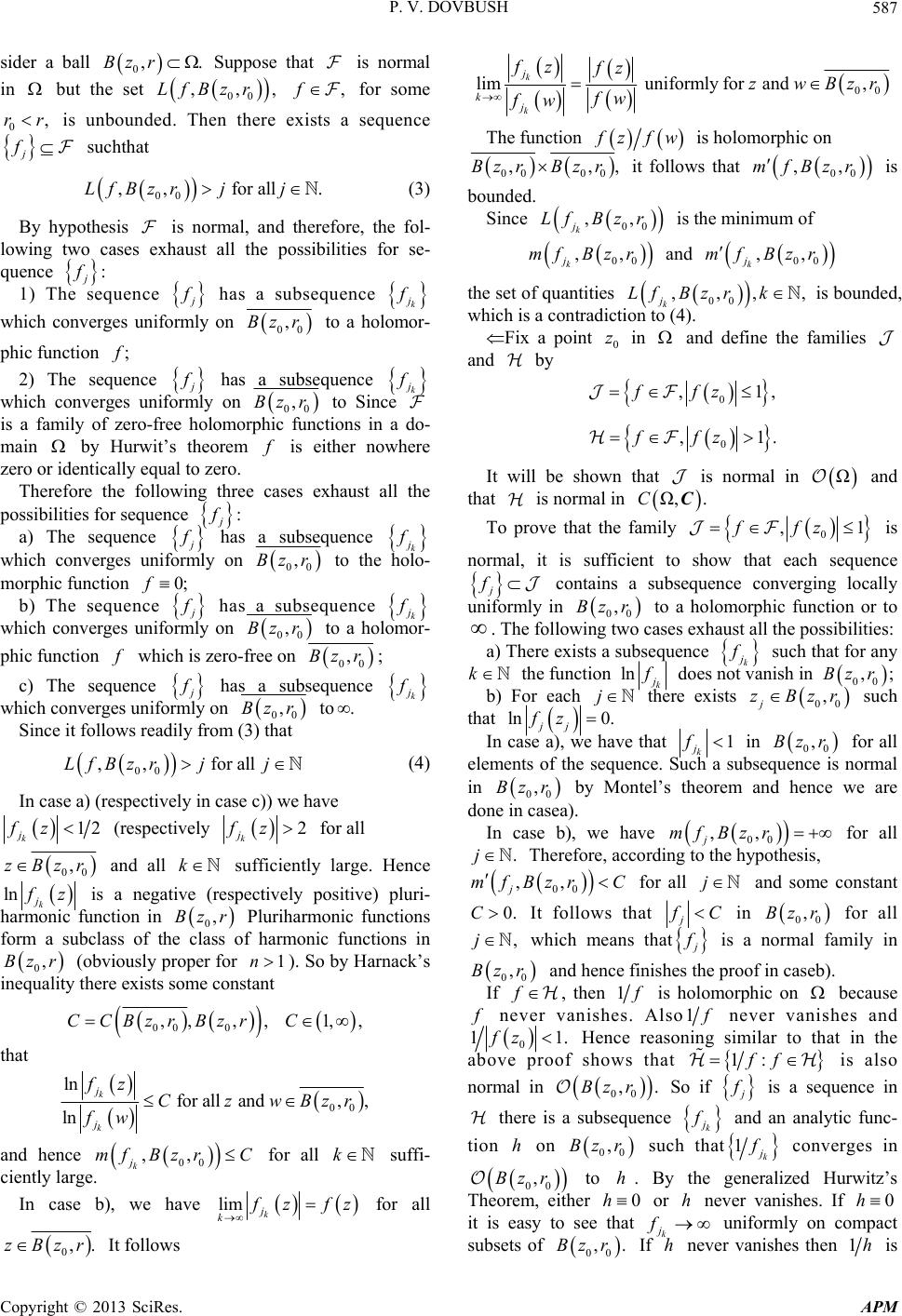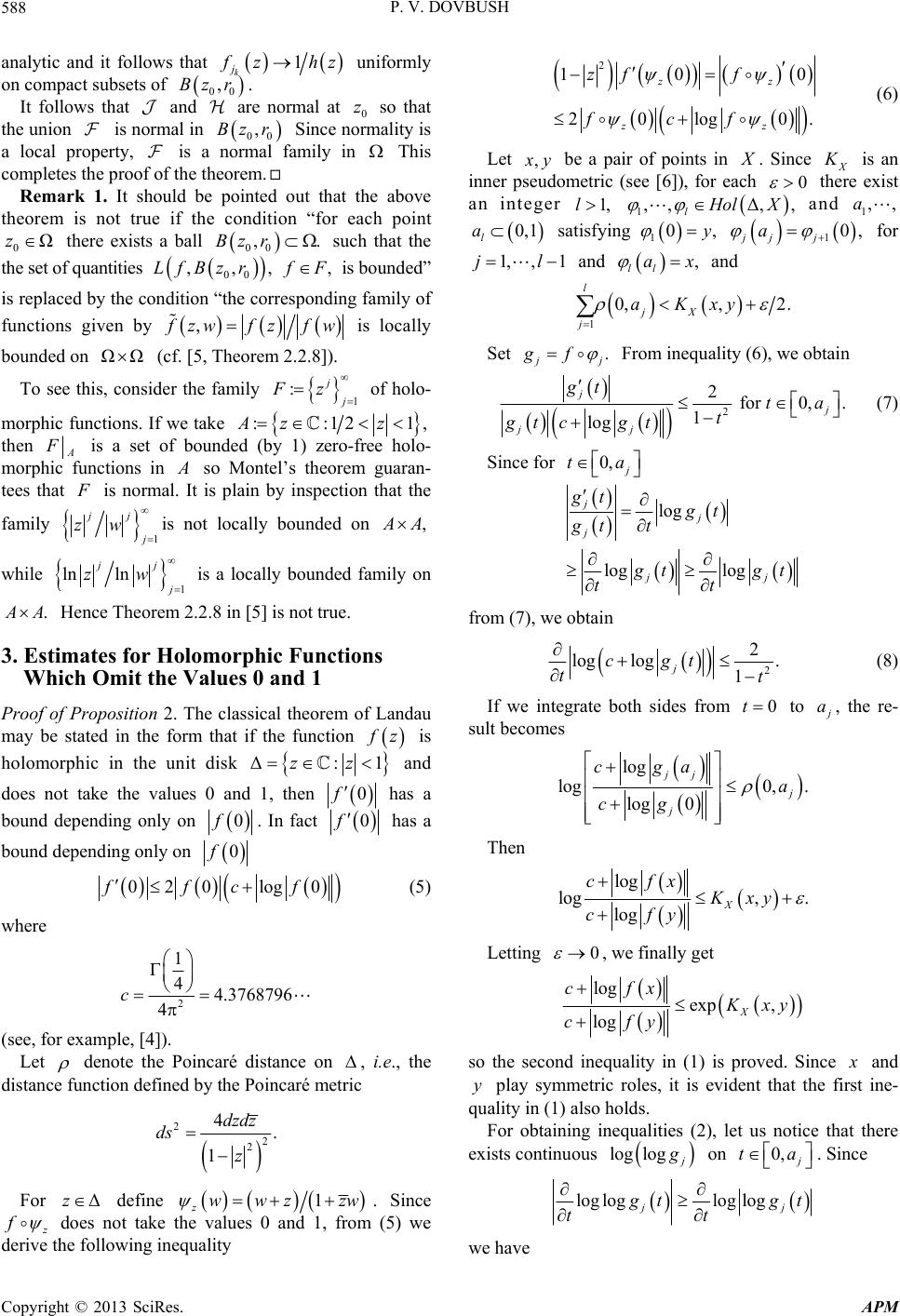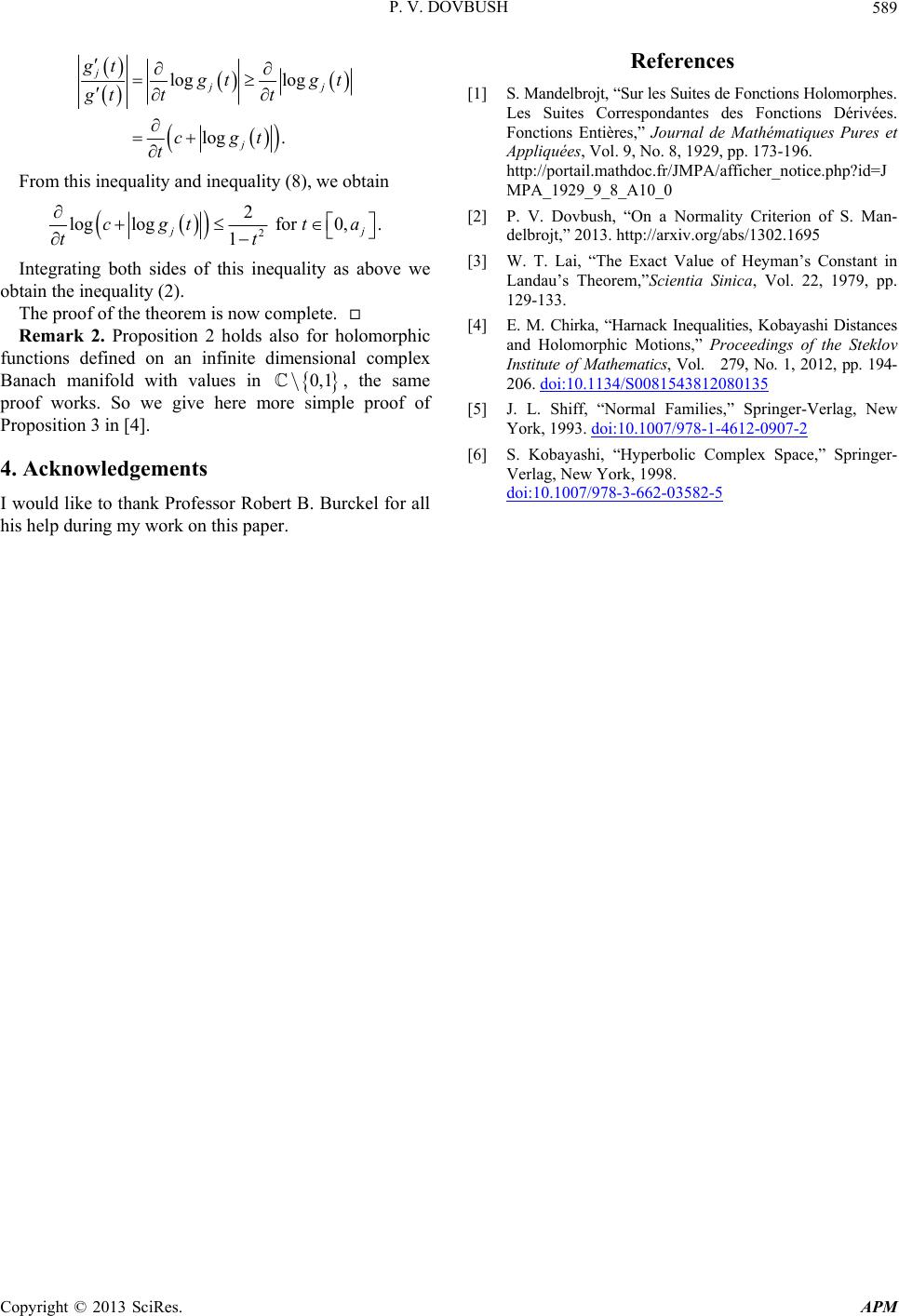 Advances in Pure Mathematics, 2013, 3, 586-589 http://dx.doi.org/10.4236/apm.2013.36075 Published Online September 2013 (http://www.scirp.org/journal/apm) Estimates for Holomorphic Functions with Values in 0,1 P. V. Dovbush Institute of Mathematics and Computer Science, Academy of Sciences of Moldova, Kishinev, Republic of Moldova Email: peter.dovbush@gmail.com Received June 29, 2013; revised July 28, 2013, accepted August 24, 2013 Copyright © 2013 P. V. Dovbush. This is an open access article distributed under the Creative Commons Attribution License, which permits unrestricted use, distribution, and reproduction in any medium, provided the original work is properly cited. Abstract Extension of classical Mandelbrojt’s criterion for normality to several complex variables is given. Some inequalities for holomorphic functions which omit values 0 and 1 are obtained. Keywords: Complex Space; Holomorphic Functions 1. Introduction In 1929, Mandelbrojt [1] has asserted his criterion for normality of a family of holomorphic zero-free functions of one complex variables. In [2], the author has proved a generalization of Man- delbrojt’s criterion to several complex variables. In order to state this criterion precisely, we introduce some nota- tions. Let be a family of zero-free holomorphic func- tions in a domain and be a subdomain in such that n D D. So that the quantities , , ln ,if1 for all ; sup ln , if1 for some , zw D mfD fz fww D fw ww D , ,, sup zw D z mfD w ,min ,,,LfDmfDm fD , are well defined for each function . f Theorem 1. (See [2].) Let be a family of holo- morphic functions in a domain with values in Then is normal in if and only if for each point 0 there exists a ball 0, 1 z 00 ,Bz r such that the the set of quantities 00 ,,LfBzr , is bounded. ,f It is well known that a family of functions holo- morphic on a domain all of which omits the values 0 and 1 is normal, so by the Theorem 00 ,,LfBzr for some 0 and all r.f But for this case we may obtain a more plain inequalities: Proposition 2. Let X be the Kobayashi distance on a connected complex space Let be the family of all holomorphic functions on .X with values in 0,1. Then, for all , yX and all ,f log exp ,log exp, , X X cfx Kxy cfy xy (1) where 2 1 44.3768796 . 4 c Furthermore, if there exists continuous log on then log exp ,log exp,. X X cfx Kxycfy Kxy (2) In the proof of this proposition, we combine the result of Lai [3] with the definition of the Kobayashi metric and obtain a very elementary proof of Proposition 3 in [4]. 2. The Proof of Mandelbrojt’s Criterion Proof of Theorem 1. Fix a point in and con- 0 z C opyright © 2013 SciRes. APM  P. V. DOVBUSH 587 sider a ball 0,Bz r LfB . Suppose that is normal in but the set for some 00 ,,zr ,f, 0,rr is unbounded. Then there exists a sequence j f suchthat 00 , ,LfBzr forall .jj (3) By hypothesis is normal, and therefore, the fol- lowing two cases exhaust all the possibilities for se- quence : j 1) The sequence has a subsequence k which converges uniformly on 00 ,Bzr to a holomor- phic function ; 2) The sequence has a subsequence k which converges uniformly on 00 ,Bzr to Since is a family of zero-free holomorphic functions in a do- main by Hurwit’s theorem is either nowhere zero or identically equal to zero. Therefore the following three cases exhaust all the possibilities for sequence : j a) The sequence has a subsequence k which converges uniformly on 00 ,Bzr to the holo- morphic function 0;f b) The sequence has a subsequence k which converges uniformly on 00 ,Bzr to a holomor- phic function which is zero-free on 00 ,Bzr; c) The sequence has a subsequence k which converges uniformly on 00 ,Bzr to . Since it follows readily from (3) that 00 ,, jBzr for all Lf j (4) In case a) (respectively in case c)) we have 12 k j fz (respectively 2 k j fz for all 00 ,zBzr and all sufficiently large. Hence k ln k j z is a negative (respectively positive) pluri- harmonic function in Pluriharmonic functions form a subclass of the class of harmonic functions in (obviously proper for ). So by Harnack’s inequality there exists some constant 0 Bz ,r 0,Bz r1n 00 0 ,,, ,CCBzrBzr 1,,C that 00 ,B ln for all and , ln k k j j fz Czwzr fw and hence 00 ,, k j mf BzrC for all suffi- ciently large. k In case b), we have lim k j k zfz for all 0,.zBzr It follows 00 lim uniformly for and , k k j kj fz fz zwBzr fw fw The function zfw is holomorphic on 00 00 ,Bz rBz r,, it follows that 00 ,,mfBzr is bounded. Since 00 ,, k j Lf Bzr is the minimum of 00 ,, k j mf Bzr and 00 ,, k j mf Bzr the set of quantities 00 ,,,Lf Bzrk, k j is bounded, which is a contradiction to (4). Fix a point in 0 z and define the families and by 0 ,1ffz , 0 ,1ffz. It will be shown that is normal in Ω and that is normal in ,.CΩC To prove that the family 0 ,1ffz is normal, it is sufficient to show that each sequence j f contains a subsequence converging locally uniformly in 00 ,Bzr to a holomorphic function or to . The following two cases exhaust all the possibilities: a) There exists a subsequence k such that for any k the function ln k does not vanish in 00 ,;Bz r b) For each j there exists such that 00 ,zr j zB ln 0. jj fz In case a), we have that 1 k j in for all elements of the sequence. Such a subsequence is normal in 00 ,Bzrf 00 ,Bzr by Montel’s theorem and hence we are done in casea). In case b), we have for all 00 ,, j mf Bzr .j Therefore, according to the hypothesis, 00 ,, j mfBzr C for all and some constant j 0.C It follows that j C in for all 00 ,Bzr ,j which means that is a normal family in 00 ,Bzr f and hence finishes the proof in caseb). If , then 1 is holomorphic on because never vanishes. Also1 never vanishes and 0 1fz 1. Hence reasoning similar to that in the above proof shows that 1:ff is also normal in 00 ,Bz r. So if is a sequence in there is a subsequence k and an analytic func- tion on h 00 ,Bzr such that 1k converges in 00 ,Bzr to . By the generalized Hurwitz’s Theorem, either h h0 or never vanishes. If h0h it is easy to see that k j uniformly on compact subsets of f 00 .,rBz If never vanishes then h1h is Copyright © 2013 SciRes. APM  P. V. DOVBUSH 588 analytic and it follows that 1 k j zhz uniformly on compact subsets of . 00 ,Bzr It follows that and are normal at 0 so that the union is normal in z 00 ,rBz Since normality is a local property, is a normal family in This completes the proof of the theorem. Remark 1. It should be pointed out that the above theorem is not true if the condition “for each point there exists a ball 0Ωz 00 ,r ,, .Bz 00 r such that the the set of quantities ,LfBz , F ised” is replaced by the condition “the corresponding family of bound functions given by , zwfzf w is locally bounded on ΩΩ (cf. [5, Theorem 2.2.8]). , consTo see thisider the family :j 1 Fz of holo- morphic functions. If we take ::121,Az z then A is a set of bounded (b- morphunctions in y 1) zero-free holo ic f so Montel’s theorem guaran- tees that is normal. It is plain by inspection that the family 1 jj is not locally bounded on , zw A while 1 ln ln j j zw is a locally bounded family on . A.2.8 in [5] is not true. Hence Theorem 2 3. Estimates for Holomorphic Functions Pr m of Landau Which Omit the Values 0 and 1 oof of Proposition 2. The classical theore may be stated in the form that if the function z is holomorphic in the unit disk Δ:1zz nd 1, then a does not take the values 0 and 0f has a bound depending only on 0f. In fact 0f has a bound depending only on 0f 0 log0cf (5) where 02ff 2 1 44.3768796 4 c (see, for example, [4]). Let denote the Poincaré distance on i.e., the die fi , stancunction defined by the Poincaré metr c 2 2 2 4. 1 dzdz ds z For define Δz 1 zwwz zw . Since f ot take t (5) we the following inequality does nhe values 0 and 1, from derive 0 20log0. zz zz f fcf (6) Let 2 10zf be a pair of points in . Since X , y is an inner pometric (see [6]), for ea 0 seud ch t exist an integer 1,l here 1,, Δ,, l ol X and 1,,a 0, 1 l a satng isfyi 10, 10 j , for jj a 1, ,jl1 and , l ax l and 1 0,, 2. lxy jX j aK Set . jj gf From inequality (6), we obtain 2 2 for 0,. 1 log j j jj gt ta t gtc gt (7) Since for 0, ta log log log jj j jj gt gt gt t tg tt t from (7), we obtain 2 2 log . 1 j gt tt (8) If we integrate both sides from su logc 0t to , the re- j a lt becomes log log0, . log 0 jj j cga a cg Then log log, . log X cfx Kxy cfy , we finally get Letting 0 log fx exp , log X c xy cfy so the second inequality in (1) is proved. Since and u y play symmetric roles, it is evident that the first ine- qality in (1) also holds. For obtaining inequalities (2), let us notice that there exists continuous log log on 0, ta . Since log logloglog jj tg tt t we have Copyright © 2013 SciRes. APM  P. V. DOVBUSH Copyright © 2013 SciRes. APM 589 References log log log . jjj j gt tg gt tt cgt t t From this inequality and inequality (8), we obtain [1] S. Mandelbrojt, “Sur les Suites de Fonctions Holomorphes. Les Suites Correspondantes des Fonctions Dérivées. Fonctions Entières,” Journal de Mathématiques Pures et Appliquées, Vol. 9, No. 8, 1929, pp. 173-196. http://portail.mathdoc.fr/JMPA/afficher_notice.php?id=J MPA_1929_9_8_A10_0 2 1 jj tt Integrating both sides of this inequality as abov ob o fu or Robert B. Burckel for all 2 log log for 0,.cgt ta [2] P. V. Dovbush, “On a Normality Criterion of S. Man- delbrojt,” 2013. http://arxiv.org/abs/1302.1695 e we [3] W. T. Lai, “The Exact Value of Heyman’s Constant in Landau’s Theorem,”Scientia Sinica, Vol. 22, 1979, pp. 129-133. tain the inequality (2). The proof of the theorem is now complete. rphic [4] E. M. Chirka, “Harnack Inequalities, Kobayashi Distances and Holomorphic Motions,” Proceedings of the Steklov Institute of Mathematics, Vol. 279, No. 1, 2012, pp. 194- 206. Remark 2. Proposition 2 holds also for holom nctions defined on an infinite dimensional complex Banach manifold with values in 0, 1, the same proof works. So we give here mole proof of Proposition 3 in [4]. 4. Acknowledgements re simp doi:10.1134/S0081543812080135 [5] J. L. Shiff, “Normal Families,” Springer-Verlag, New York, 1993. doi:10.1007/978-1-4612-0907-2 [6] S. Kobayashi, “Hyperbolic Complex Space,” Springer- Verlag, New York, 1998. doi:10.1007/978-3-662-03582-5 I would like to thank Profess his help during my work on this paper.
|